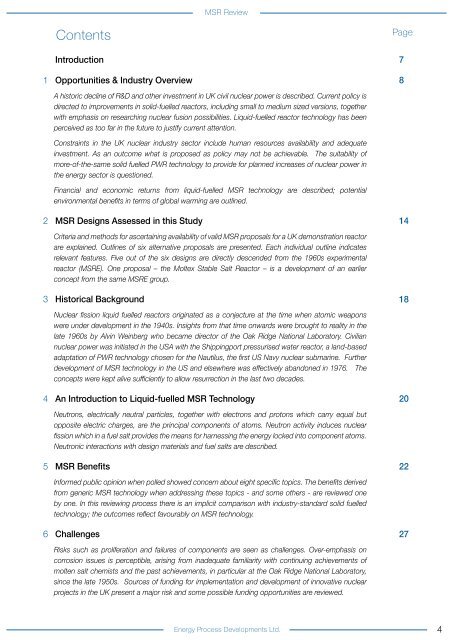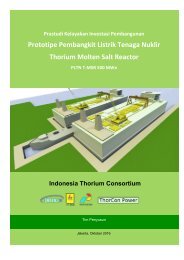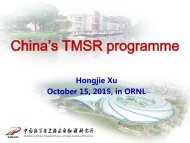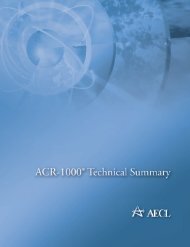MSR Review
EPD MSR Review Feasibility Study July 2015 1.02
EPD MSR Review Feasibility Study July 2015 1.02
You also want an ePaper? Increase the reach of your titles
YUMPU automatically turns print PDFs into web optimized ePapers that Google loves.
<strong>MSR</strong> <strong>Review</strong><br />
Contents<br />
1 Introduction<br />
1 Opportunities & Industry Overview<br />
Page<br />
7<br />
8<br />
A historic decline of R&D and other investment in UK civil nuclear power is described. Current policy is<br />
directed to improvements in solid-fuelled reactors, including small to medium sized versions, together<br />
with emphasis on researching nuclear fusion possibilities. Liquid-fuelled reactor technology has been<br />
perceived as too far in the future to justify current attention.<br />
Constraints in the UK nuclear industry sector include human resources availability and adequate<br />
investment. As an outcome what is proposed as policy may not be achievable. The suitability of<br />
more-of-the-same solid fuelled PWR technology to provide for planned increases of nuclear power in<br />
the energy sector is questioned.<br />
Financial and economic returns from liquid-fuelled <strong>MSR</strong> technology are described; potential<br />
environmental benefits in terms of global warming are outlined.<br />
2 <strong>MSR</strong> Designs Assessed in this Study<br />
14<br />
Criteria and methods for ascertaining availability of valid <strong>MSR</strong> proposals for a UK demonstration reactor<br />
are explained. Outlines of six alternative proposals are presented. Each individual outline indicates<br />
relevant features. Five out of the six designs are directly descended from the 1960s experimental<br />
reactor (<strong>MSR</strong>E). One proposal – the Moltex Stable Salt Reactor – is a development of an earlier<br />
concept from the same <strong>MSR</strong>E group.<br />
3 Historical Background<br />
Nuclear fission liquid fuelled reactors originated as a conjecture at the time when atomic weapons<br />
were under development in the 1940s. Insights from that time onwards were brought to reality in the<br />
late 1960s by Alvin Weinberg who became director of the Oak Ridge National Laboratory. Civilian<br />
nuclear power was initiated in the USA with the Shippingport pressurised water reactor, a land-based<br />
adaptation of PWR technology chosen for the Nautilus, the first US Navy nuclear submarine. Further<br />
development of <strong>MSR</strong> technology in the US and elsewhere was effectively abandoned in 1976. The<br />
concepts were kept alive sufficiently to allow resurrection in the last two decades.<br />
4 An Introduction to Liquid-fuelled <strong>MSR</strong> Technology<br />
18<br />
20<br />
Neutrons, electrically neutral particles, together with electrons and protons which carry equal but<br />
opposite electric charges, are the principal components of atoms. Neutron activity induces nuclear<br />
fission which in a fuel salt provides the means for harnessing the energy locked into component atoms.<br />
Neutronic interactions with design materials and fuel salts are described.<br />
5 <strong>MSR</strong> Benefits<br />
Informed public opinion when polled showed concern about eight specific topics. The benefits derived<br />
from generic <strong>MSR</strong> technology when addressing these topics - and some others - are reviewed one<br />
by one. In this reviewing process there is an implicit comparison with industry-standard solid fuelled<br />
technology; the outcomes reflect favourably on <strong>MSR</strong> technology.<br />
6 Challenges<br />
Risks such as proliferation and failures of components are seen as challenges. Over-emphasis on<br />
corrosion issues is perceptible, arising from inadequate familiarity with continuing achievements of<br />
molten salt chemists and the past achievements, in particular at the Oak Ridge National Laboratory,<br />
since the late 1950s. Sources of funding for implementation and development of innovative nuclear<br />
projects in the UK present a major risk and some possible funding opportunities are reviewed.<br />
22<br />
27<br />
Energy Process Developments Ltd. 4





